
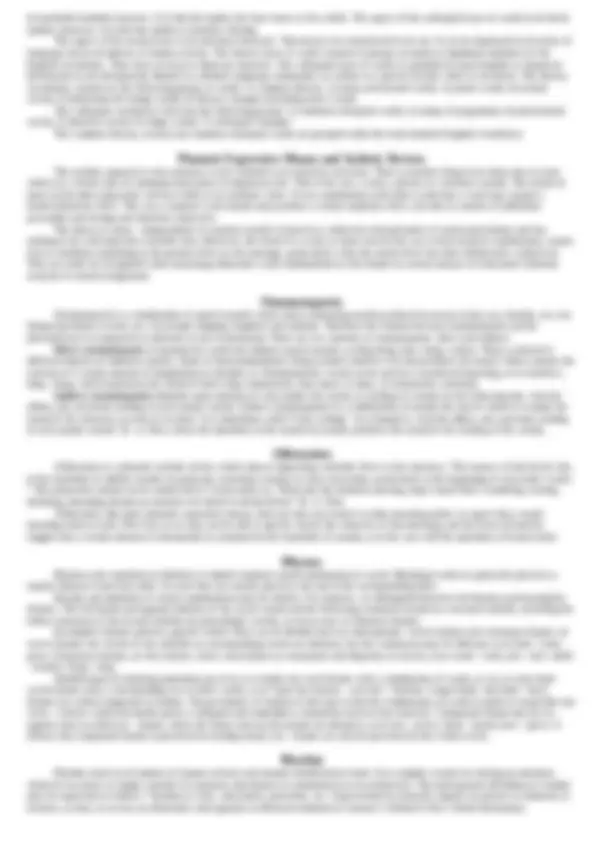
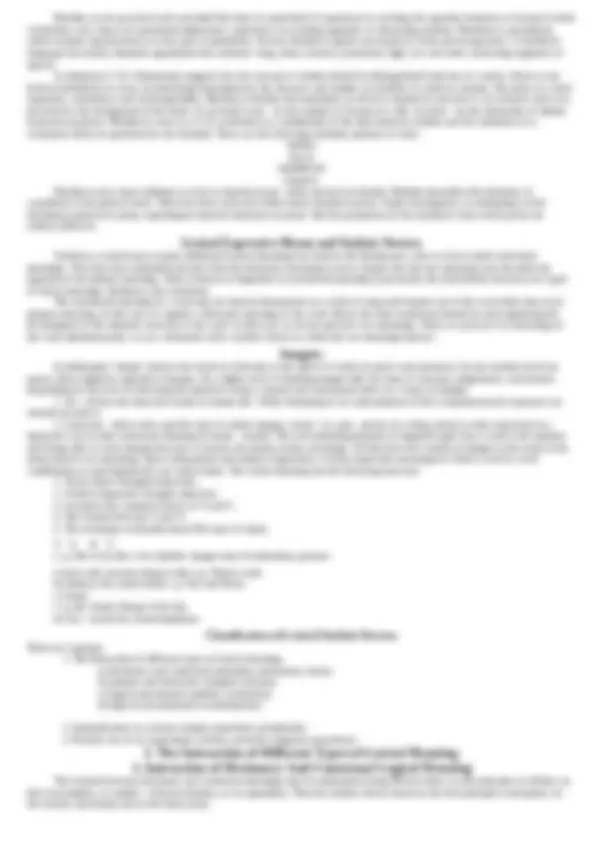
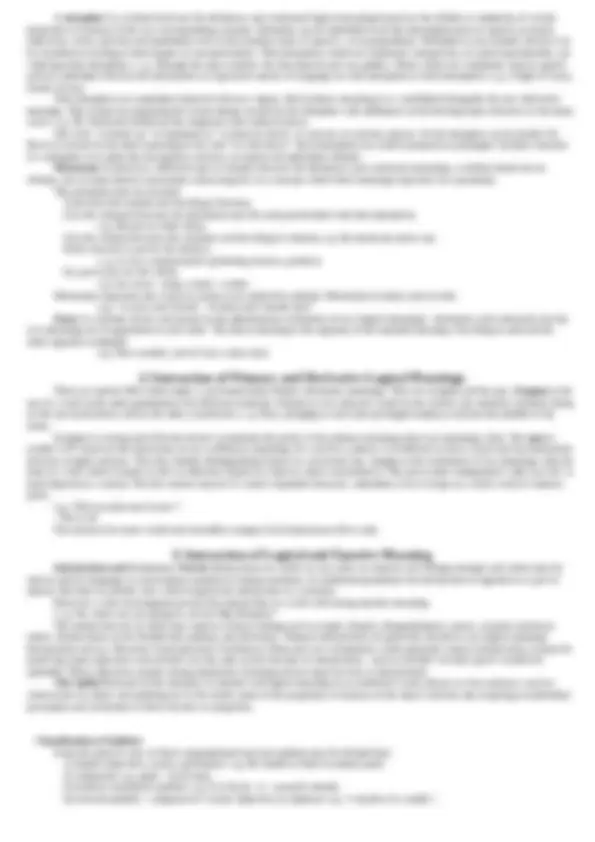
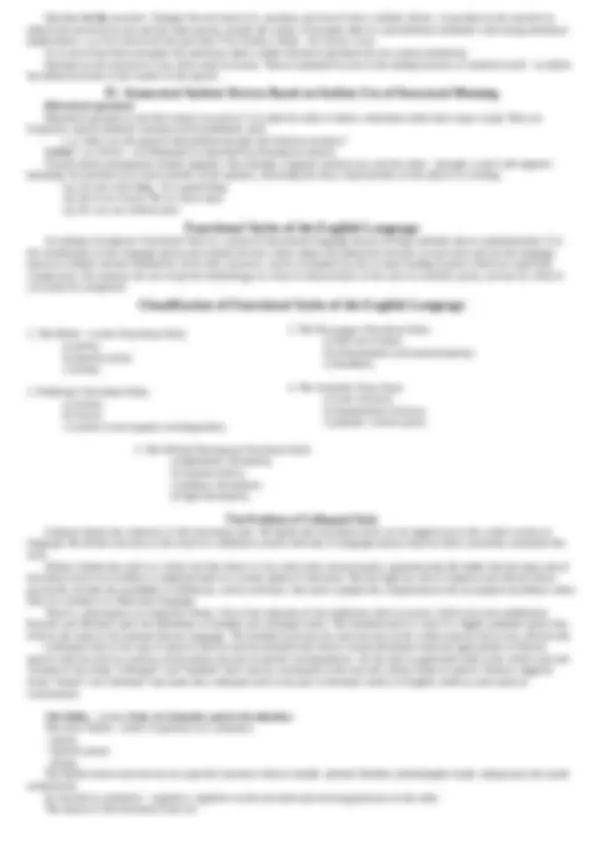
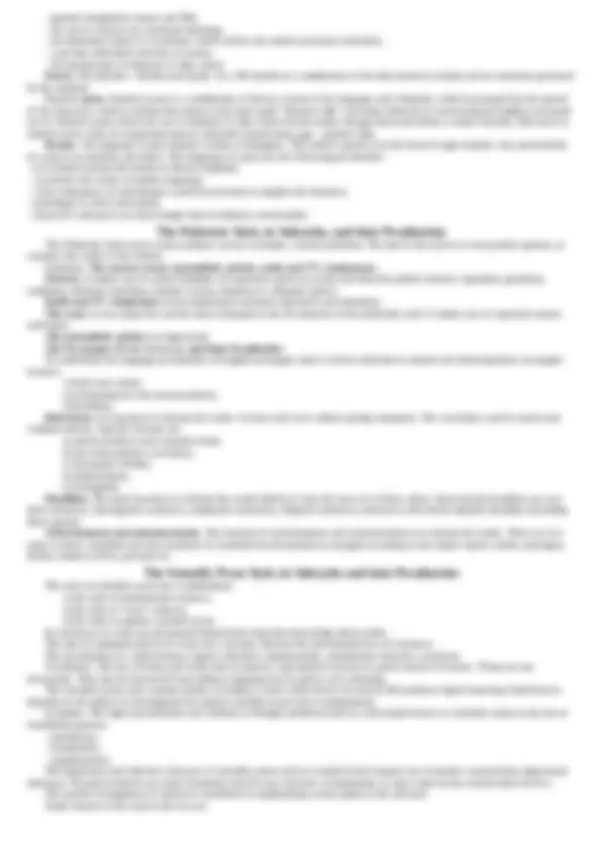
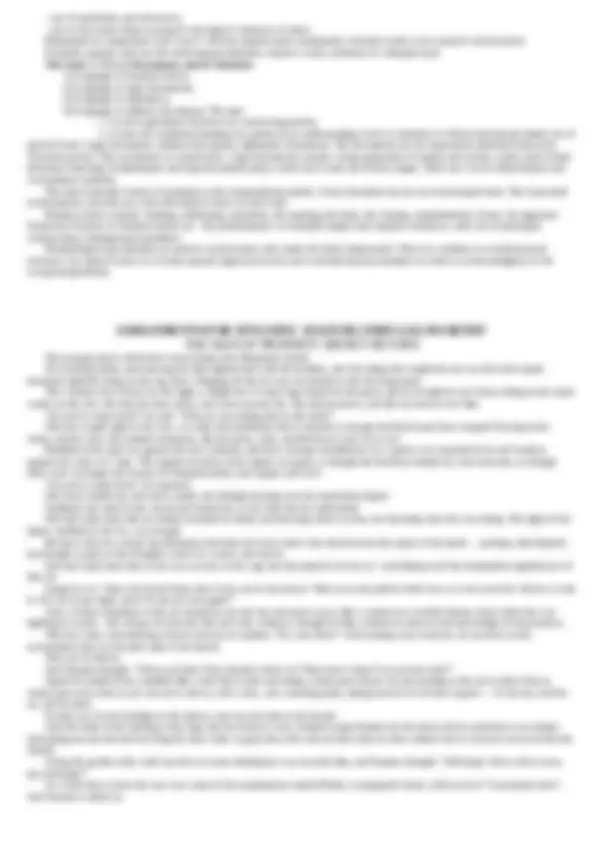
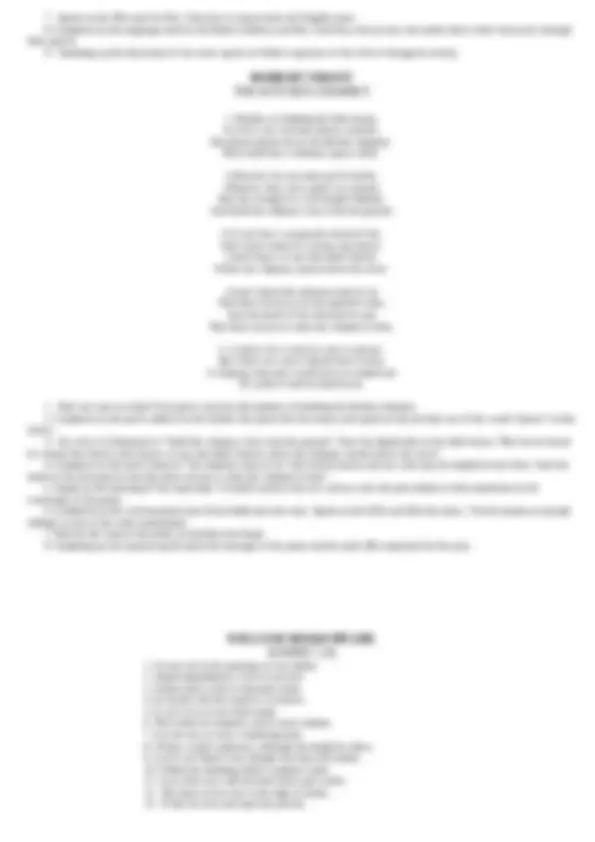
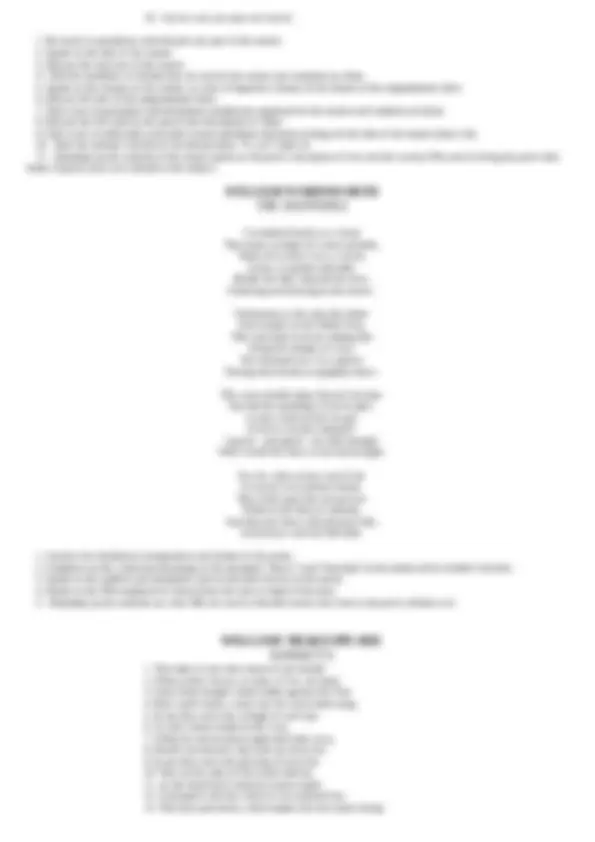
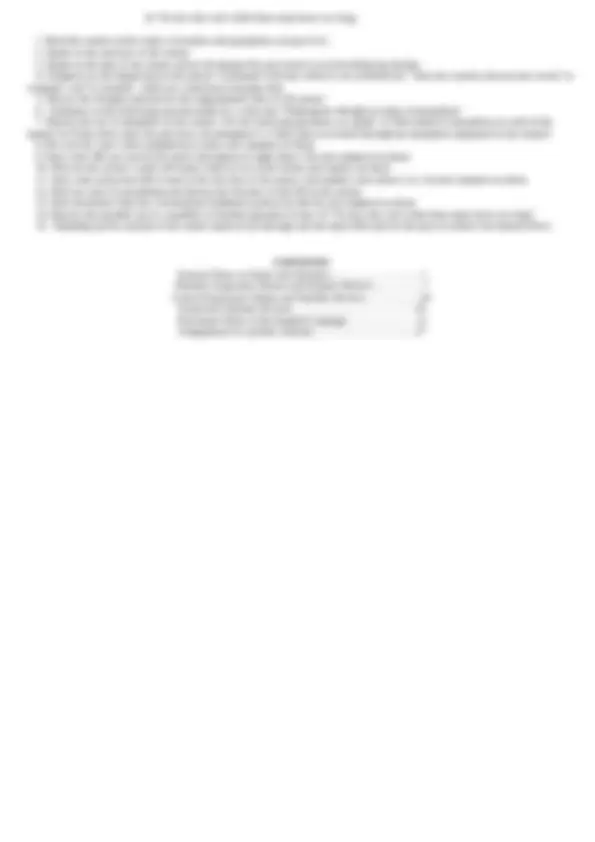


Study with the several resources on Docsity

Earn points by helping other students or get them with a premium plan


Prepare for your exams
Study with the several resources on Docsity

Earn points to download
Earn points by helping other students or get them with a premium plan
Community
Ask the community for help and clear up your study doubts
Discover the best universities in your country according to Docsity users
Free resources
Download our free guides on studying techniques, anxiety management strategies, and thesis advice from Docsity tutors
This is our module from our Instructor and Professor
Typology: Schemes and Mind Maps
1 / 15

This page cannot be seen from the preview
Don't miss anything!










The subject of stylistics has so far not been definitely outlined. This is due to a number of reasons. First of all there is a confusion between the terms style and stylistics. The first concept is so broad that it is hardly possible to regard it as a term. We speak of style in architecture, literature, behaviour, linguistics, dress and other fields of human activity Even in linguistics the word style is used so widely that it needs interpretation. The majority of linguists who deal with the subject of style agree that the term applies to the following fields of investigation.:
Rhythm can be perceived only provided that there is some kind of experience in catching the opposite elements or features in their correlation, and, what is of paramount importance, experience in catching regularity of alternating patterns. Rhythm is a periodicity, which requires specification as to the type of periodicity. Inverse rhythm is regular succession of weak and strong stress. A rhythm in language necessarily demands oppositions that alternate: long, short; stressed, unstressed; high, low and other contrasting segments of speech. Academician V.M. Zhirmunsky suggests that the concept of rhythm should be distinguished from that of a metre. Metre is any form of periodicity in verse, its kind being determined by the character and number of syllables of which it consists. The metre is a strict regularity, consistency and unchangeability. Rhythm is flexible and sometimes an effort is required to perceive it. In classical verse it is perceived at the background of the metre. In accented verse - by the number of stresses in a line. In prose - by the alternation of similar syntactical patterns. Rhythm in verse as a S. D. is defined as a combination of the ideal metrical scheme and the variations of it, variations which are governed by the standard. There are the following rhythmic patterns of verse: iambus dactul umphibrach anapaest. Rhythm is not a mere addition to verse or emotive prose, which also has its rhythm. Rhythm intensifies the emotions. It contributes to the general sense. Much has been said and writhen about rhythm in prose. Some investigators, in attempting to find rhythmical patterns of prose, superimpose metrical measures on prose. But the parametres of the rhythm in verse and in prose are entirely different. Lexical Expressive Means and Stylistic Devices Words in a context may acquire additional lexical meanings not fixed in the dictionaries, what we have called contextual meanings. The latter may sometimes deviate from the dictionary meaning to such a degree that the new meaning even becomes the opposite of the primary meaning. What is known in linguistics as transferred meaning is practically the interrelation between two types of lexical meaning: dictionary and contextual. The transferred meaning of a word may be fixeв in dictionaries as a result of long and frequent use of the word other than in its primary meaning. In this case we register a derivative meaning of the word. Hence the term transferred should be used signifying th£ development of the semantic structure of the word. In this case we do not perceive two meanings. When we perceive two meanings of the word simultaneously, we are confronted with a stylistic device in which the two meanings interact. Imagery In philosophy "image" denotes the result of reflection of the object of reality in man's consciousness. On the sensible level our senses, ideas might be regarded as images. On a higher level of thinking images take the form of concepts, judgements, conclusions. Depending on the level of reflecting the objective reality ( sensual and conceptual) there are 2 types of images:
There are 3 groups.
The relation between dictionary and contextual meanings may be maintained along different lines: on the principle of affinity, on that of proximity, or symbol - referent relations, or on opposition. Thus the stylistic device based on the first principle is metaphor, on the second, metonymy and on the third, irony
A metaphor is a relation between the dictionary and contextual logical meanings based on the affinity or similarity of certain properties or features of the two corresponding concepts. Metaphor can be embodied in all the meaningful parts of speech, in nouns, adjectives, verbs, adverbs and sometimes even in the auxiliary parts of speech , as in prepositions. Metaphor as any stylistic devices can be classified according to their degree of unexpectedness. Thus metaphors which are absolutely unexpected, are quite unpredictable, are called genuine metaphors. e. g. Through the open window the dust danced and was golden. Those which are commonly used in speech and are sometimes fixed in the dictionaries as expressive means of language are trite metaphors or dead metaphors e. g. a flight of fancy, floods of tears. Trite metaphors are sometimes injected with new vigour, their primary meaning is re- established alongside the new derivative meaning. This is done by supplying the central image created by the metaphor with additional words bearing some reference to the main word. e. g. Mr. Pickwick bottled up his vengeance and corked it down. The verb " to bottle up " is explained as " to keep in check", to conceal, to restrain, repress. So the metaphor can be hardly felt. But it is revived by the direct meaning of the verb "to cork down". Such metaphors are called sustained or prolonged. Stylistic function of a metaphor is to make the description concrete, to express the individual attitude. Metonymy is based on a different type of relation between the dictionary and contextual meanings, a relation based not on affinity, but on some kind of association connecting the two concepts which these meanings represent on a proximity The proximity may be revealed:
There are special SDs which make a word materialize distinct dictionary meanings. They are zeugma and the pun. Zeugma is the use of a word in the same grammatical but different semantic relations to two adjacent words in the context, the semantic relations being on the one hand literal, and on the other, transferred. e. g. Dora, plunging at once into privileged intimacy and into the middle of the room. Zeugma is a strong and effective device to maintain the purity of the primary meaning when two meanings clash. The pun is another S.D. based on the interaction of two wellknown meanings of a word or a phrase. It is difficult to draw a hard and fast distinction between zeugma and pun. The only reliable distinguishing feature is a structural one: zeugma is the realization of two meanings with the help of a verb which is made to refer to different subjects or objects ( direct and indirect). The pun is more independent. Like any S.D. it must depend on a context. But the context may be of a more expanded character, sometimes even as large as a whole work of emotive prose. e.g.- Did you miss my lecture?
Interjections and Eclamatory Words Interjections are words we use when we express our feelings strongly and which may be said to exist in language as conventional symbols of human emotions. In traditional grammars the interjection is regarded as a part of speech. But there is another view which regards the interjection as a sentence. However a close investigation proves that interjection is a word with strong emotive meaning. e. g. Oh, where are you going to, all you Big Steamers? The interjection oh, by itself may express various feelings such as regret, despair, disappointment, sorrow, surprise and many others. Interjections can be divided into primary and derivative. Primary interjections are generally devoid of any logical meaning. Interjections such as: Heavens! Good gracious! God knows! Bless me! are exclamatory words generally used as interjections. It must be noted that some adjectives and adverbs can also take on the function of interjections - such as terrible! awfully! great! wonderful! splendid! These adjectives acquire strong emotional colouring and are equal in force to interjections. The epithet is based on the interplay of emotive and logical meaning in an attributive word, phrase or even sentence, used to characterize an object and pointing out to the reader some of the properties or features of the object with the aim of giving an individual perception and evaluation of these features or properties. Classification of Epithets From the point of view of their compositional structure epithets may be divided into:
Repetition. Enumeration. Suspense. Climax. Antithesis. II. Peculiar linkage Asyndeton. Polysyndeton. Gap - sentence - link. III. Colloquial constructions Ellipsis. Aposiopesis. Question - in - the narrative. Represented speech. IV. Stylistic use of structural Rhetorical questions,. meaning Litotes.
They include: stylistic inversion, detached constructions, parallel constructions , chiasmus, suspense, climax, antithesis. Stylistic Inversion. The English word order is fixed. Any change which doesn't influence the meaning but is only aimed at emphasis is called a stylistic inversion. Stylistic inversion aims at attaching logical stress or additional emotional colouring to the surface meaning of the utterance. Therefore a specific intonation pattern is the inevitable satellite of inversion. The following patterns of stylistic inversion are most frequently met in both English prose and English poetry.
Asyndeton is a deliberate avoidance of conjunctions in constructions in which they would normally used. e.g. He couldn't go abroad alone, the sea upset his liver, he hated hotels. Polysyndeton - is an identical repetition of conjunctions: used to emphasize simultaneousness of described actions, to disclose the authors subjective attitude towards the characters, to create the rhythmical effect. e. g. The heaviest rain, and snow, and hail, and sleet, could boast of the advantage over him in only one respect. Gap - sentence - link It presents two utterances the second is brought into the focus of the reader's attention. e. g. She and that fellow ought to be the sufferers, and they were in I tally. III. Syntactical Stylistic Devices Based on Peculiar Use of Colloquial Constructions Ellipsis, break in the narrative, represented speech. Ellipsis - is the omition of a word necessary for the complete syntactical construction of a sentence, but not necessary for understanding. The stylistic function of ellipsis used in author's narration is to change its tempo, to connect its structure. e. g. You feel all right? Anything wrong or what? Aposiopesis (Break - in - the narrative). Sudden break in the narration has the function to reveal agitated state of the speaker. e. g. On the hall table there were a couple of letters addressed to her. One was the bill. The other... There are 3 ways of reproducing character's speech.
Question in the narrative. Changes the real nature of a question and turns it into a stylistic device. A question in the narrative is asked and answered by one and the same person, usually the author. It becomes akin to a parenthetical statement with strong emotional implications. e. g. For what is left the poet here? For Greeks a blush - for Greece a tear. As is seen from these examples the questions asked, unlike rhetorical questions do not contain statements. Question in the narrative is very often used in oratory. This is explained by one of the leading features of oratorical style - to induce the desired reaction to the content of the speech. IV. Syntactical Stylistic Devices Based on Stylistic Use of Structural Meaning Rhetorical questions. Rhetorical question is one that expects no answer. It is asked in order to make a statement rather than to get a reply They are frequently used in dramatic situation and in publisistic style. e. g. What was the good of discontented people who fitted in nowhere? Litotes - is a device - an affirmation is expressed by denying its contrary Usually litotes presupposes double negation. One through a negative particle (no, not) the other - through a word with negative meanixig. Its function is to convey doubts of the speaker concerning the exact characteristics of the object or a feeling. e.g. It's not a bad thing - It's a good thing. e.g. He is no coward. He is a brave man. e.g. He was not without taste.
According to Galperin: Functional Style is a system of interrelated language means serving a definite aim in communication. It is the coordination of the language means and stylistic devices which shapes the distinctive features of each style and not the language means or stylistic devices themselves. Each style, however, can be recoquized by one or more leading features which are especially conspicuous. For instance the use of special terminology is a lexical characteristics of the style of scientific prose, and one by which it can easily be recognized.
a) poetry; b) emotive prose; c) drama;
Galperin denies the existence of this functional style. He thinks that functional style can be singled out in the written variety of language. He defines the style as the result of a deliberate careful selection of language means which in their correlation constitute this style. Maltzev thinks that style is a choice but this choice is very often done unconsciously, spontaneously He thinks that the main aim of functional style is to facilitate a communication in a certain sphere of discourse. But the rigid lay outs of business and official letters practically exclude the possibility of deliberate, careful selection. One more example the compression in the newspapers headlines where there is a tendency to abbreviate language. There's a descrepancy in Galperin's theory. One of the substyles of the publicistic style is oratory which is its oral subdivision. Kuznetz and Skrebnev give the definitions of bookish and colloquial styles. The bookish style is a style of a highly polished nature that reflects the norm of the national literary language. The bookish style may be used not only in the written speech but in oral, official talk. Colloquial style is the type of speech which is used in situation that allows certain deviations from the rigid pattern of literary speech used not only in a private conversation, but also in private correspondence. So the style is applicable both to the written and oral varieties of the terms "colloquial" and "bookish" don't exactly correspond to the oral and written forms of speech. Maltzev suggests terms "formal" and "informal" and states that colloquial style is the part of informal variety of English which is used orally in conversation. The Belles - Lettres Style, its Substyles and its Peculiarities The term "Belles - lettres" is generic for 3 substyles:
From far in the clear air the bells of the church where he and Irene had been married were pealing in "practice" for the advent of Christ, the chimes ringing out above the sound of traffic. He felt a craving for strong drink, to lull him to indifference, or rouse him to fury. If only he could burst out of himself, out of this web that for the first time in his life he felt around him. If only he could surrender to the thought: "Divorce her - turn her out! She has forgotten you. Forget her!" If only he could surrender to the thought: "Let her go - she has suffered enough!" If only he could surrender to the desire: "Make a slave of her- she is in your power!" If only even he could surrender to the sudden vision: "What does it all matter?" Forget himself for a minute, forget that it mattered what he did, forget that whatever he did he must sacrifice something. If only he could ad on an impulse! He could forget nothing; surrender to no thought, vision, or desire; it was all too serious; too close around him, an unbreakable cage. On the far side of the Square newspaper boys were calling their evening wares, and the ghoulish cries mingled and jangled with the sound of those church bells. Soames covered his ears. The thought flashed across him that but for a chance, he himself, and not Bosinney, might be lying dead, and she, instead of crouching there like a shot bird with those dying eyes -
THE GREAT GATSBY The passage deals with the description of the major character of the novel and American society after World War I. He did extraordinarily well in the war. He was a captain before he went to the front, and following the Argonne bat ties he got his majority and the command of the divisional machine-guns. After the Armistice he tried frantically to get home, but some complication or misunderstanding sent him to Oxford instead. He was worried now -there was a quality of nervous despair in Daisy's letters. She didn't see why he couldn't come. She was feeling the pressure of the world outside, and she wanted to see him and feel his presence beside her and be reassured that she was doing the right thing after all. For Daisy was young and her artificial world vas redolent of orchids and pleasant, cheerful snobbery and orchestras which set the rhythm of theyear, summing up the sadness and suggestiveness of life in newtunes. All night the saxophones wailed the hopeless comment of the "Beale Street Blues" while a hundred pairs of golden and silver slippers shuffled the shining dust. At the gray tea hour there were always rooms that throbbed incessantly with this low, sweet fever, while fresh faces drifted here and there like rose petals blown by the sad horns around the floor. Through this twilight universe Daisy began to move again with the season; suddenly she was again keeping half a dozen dates a day with half a dozen men, and drowsing asleep at dawn with the beads and chiffon of an evening dress tangled among dying orchids on the floor beside her bed. And all the time something within her was crying for a decision. She wanted her life shaped now, immediately- and the decision must be made by some force - of love, of money, of unquestionable practicality - that was close at hand. That force took shape in the middle of spring with the arrival of Tom Buchanan. There was a wholesome bulkiness about his person and his position, and Daisy was flattered. Doubtless there was a certain struggle and a certain relief. The letter reached Gatsby while he was still at Oxford.
Mrs. Chiveley, a cunning adventuress, comes to sir Robert Chiltem - a prominent public figure with the purpose of backmailing him. Mrs.Cheveley: Sir Robert, I will be quite frank with you. I want you to withdraw the report that you had intended to lay before the House, on the ground that you have reasons to believe that the Commissioners have been prejudiced or misinformed, or something. Then I want you to say a few words to the effect that the Government is going to reconsider the question, and that you have reason to believe that the Canal, if completed, will be of great international value. You know the sort of things ministers say in cases of this kind. A few ordinary platitudes will do. In modern life nothing produces such an effect as a good platitude. It makes the whole world kin. Will you dc that for me? Sir. RobertChiltern: Mrs. Cheveley you cannot be serious in making me such a proposition! Mrs.Cheveley: I am quite serious.
THE KITCHEN CHIMNEY 1 .Builder, in building the little house, In every way you may please yourself; But please please me in the kitchen chimney: Don't build me a chimney upon a shelf. 2.However far you must go for bricks. Whatever they cost a-piece or a pound, Buy me enough for a full-length chimney And build the chimney clear from the ground. 3.1t's not that 1 am greatly afraid of fire, But I never heard of a house that throve (And I know of one that didn't thrive) Where the chimney started above the stove. 4.And I dread the ominous stain of tar That there always is on the papered walls, And the smell of fire drowned in rain That there always is when the chimney's false.